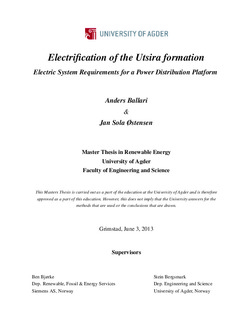| dc.contributor.author | Ballari, Anders | |
| dc.contributor.author | Østensen, Jan Sola | |
| dc.date.accessioned | 2013-09-16T09:02:00Z | |
| dc.date.available | 2013-09-16T09:02:00Z | |
| dc.date.issued | 2013 | |
| dc.identifier.uri | http://hdl.handle.net/11250/136731 | |
| dc.description | Masteroppgave i fornybar energi ENE500 2013 – Universitetet i Agder, Grimstad | no_NO |
| dc.description.abstract | The Norwegian oil and energy department instructs operators to look at the possibility for electrification
of future offshore installations with power from shore. The offshore installations at the
Utsira formation may be suitable for this due to a high power demand and the distance from shore.
The objective of this thesis has been to investigate requirements for an electrical power distribution
system for these installations. A power distribution platform recieves power from the
onshore grid through a HVDC link and distributes it through high-voltage AC cables to the offshore
installations. The focus has been on the high-voltage AC part of the distribution system.
Requirements and capacities for the following components have been investigated:
Voltage source converter
Transformers
Circuit breakers
HVAC Transmission cables
In addition the option of integrating an offshore wind power plant in the high-voltage AC
distribution system has been evaluated, as well as the modifications required for the mentioned
components and the topology of the distribution system.
A Simulink model of the distribution system was developed to test the solution for different
load conditions. The offshore installations were modelled as a number of 28MWinduction motors
with a power factor of 0.9. The voltage source converter was simplified to a constant power source
and modelled as two PI controllers for power and voltage.
The system currents and voltage levels from the steady state analysis are regarded as good
estimates for the future realization of the distribution system with only power from shore. Future
steady state analysis of the distribution system should look to the values presented in this thesis in
order to verify if their results are within reasonable range.
With a wind power plant (WPP) the system components must be able to withstand a higher
short circuit current and the circuit breaker ratings must be modified. To avoid this, a current limiter (Is-limiter) could be introduced, which will prohibit the short circuit current contribution
from the wind power plant. A new transformer will be required within the distribution system, and
the capacity must be equal to the maximum capacity of the wind power plant.
If the floating wind turbine technology evolves, a WPP together with power from shore should
be capable of supplying offshore installations with power. The fast response and versatile control
of the voltage source converter makes it well suitable for balancing the power of the WPP. The
balancing would also require a maximum power reserve equal to the WPP capacity in the onshore
grid.
The offshore installations at Utsira formation is planned to start production in 2016 and will be
operational to 2060. These installation could either be run with gas driven turbines located on the
platforms or be supplied with power from onshore. Global warming and the world’s demand for
gas may call for measures to supply future offshore installations with power from shore. This thesis
has shown that there are few technological restraints for the electrification of the Utsira formation
with power from shore. | no_NO |
| dc.language.iso | eng | no_NO |
| dc.publisher | Universitetet i Agder / University of Agder | no_NO |
| dc.title | Electrification of the Utsira formation : electric system requirements for a power distribution platform | no_NO |
| dc.type | Master thesis | no_NO |
| dc.source.pagenumber | XII, 81, [60] | no_NO |
